At the meeting of the 17th session of the World Heritage Committee (WHC) in Columbia, from the 6th to the 11th of December 1993, UNESCO has come to the decision of recognising the architectural ensemble of Hue as a world cultural heritage. On 2 August 1994, the delivery of the recognising text has been organised at the Imperial Palace of Hue. This was a noteworthy event in the cultural history since that Hue is the first site in Vietnam ever listed in the World Heritage list.
|
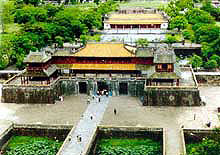
Overview of Hoang Thanh |
The WHC has briefly assessed the value of Hue as: “The architecture of Hue, which has been the Capital of a unified Vietnam, built at about the beginning of the 19th century, combines the oriental philosophy with the traditions of Vietnam. Intimately mingled with the natural environment, the beauty and special richness of the architecture and decorative art of the building are an original image of the Vietnamese monarchy at its most prosperous periodâ€. |
Hue, a World Heritage site and one of the most popular destinations for visitors to Vietnam, is a mysterious, peaceful city with a unique cultural identity. It is, full of lakes, canals, lush vegetation and magnificent historical sights, including the early 19th century walled citadel, dozens of Buddhist temples and complexes of royal tombs.
The wonders of Hue can hardly be described to do them justice, and the best way to discover them is still to come in person and admire the beautiful constructions. Tourists can spend the day strolling the royal land that covers over 500 hectares and is surrounded by Kinh Thanh (Capital Citadel), Hoang Thanh (Royal City or Imperial City) and Tu Cam Thanh (Forbidden City).
| Kinh Thanh Hue (Hue Capital Citadel)
This construction started in 1805 under the reign of King Gia Long and completed in 1832 under the reign of King Ming Mang. Under Nguyen Dynasty, the Kings had ordered to build ramparts, palaces and constructional works for royal. Over 200 years to now, it is still original with nearly 140 small and large constructions. |
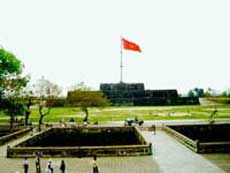
Flag Tower in Kinh Thanh Hue |
Besides, the Citadel has an ancillary gate connecting the Tran Binh Bastion called the Thai Binh Mon (Peace Gate).
Hoang Thanh (Royal Citadel or Imperial City)
The Imperial City is located in the centre of the Citadel, where established highest offices of Vietnam's feudalism and sanctums honouring the cult of decreased Kings.
Access to the Imperial City can be made by four entrance gates. The first impression should be Ngo Mon Gate, which is fantastic and filled with secrets and stands imposingly in the green-moss-covered wall surrounded by a lotus canal. Royal Citadel consists of more 100 beautiful constructional works divided many sectors:
|
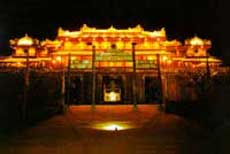
Ngo Mon Gate in Hoang Thanh
|
- Sector for the Ngo Mon Gate and the Thai Hoa Palace: This is the place for setting up various grand ceremonies.
- Sector for worship shrines of the Kings Nguyen: Trieu Mieu, Thai Mieu, Hung Mieu, The Mieu and Phung Tien Temples.
- Sector for internal affairs office: Storehouse for precious objects, workshop for manufacturing various useful articles.
|
- Sectors for the Kham Van Palace and the Co Ha Garden: place where the princes are studying or enjoying.
Legend says that Hoang Thanh was originally built from clay, then from brick under King Gia Long.
Tu Cam Thanh (Forbidden Citadel)
Located inside the Imperial City, behind the Throne Palace, the Forbidden Citadel is reserved for King and his family. It was constructed early under reign of King Gia Long in 1804, including 50 architectural constructions of different sizes and 7 gates for facilities of entrance and exit. Dai Cung Mon (the Great Palace Gate) is in the front side for the Kings. Can Chanh Palace (the place for daily working of Kings). Can Thanh (King's Private Palace), Khon Thai Residence (Queen's Private Apartment) reserved for the Queen. Duyet Thi Duong house (Royal Theatre), Thuong Thien (the kitchen for the Kings' food), Thai Binh Lau (King's reading room)...
| Complexes of royal tombs
In addition, Hue is also well-known for the royal complexes of tomb. All the complexes were constructed during the reign of the respective king for which they were named and each complex was laid out with statues and monuments in perfect harmony with one another to form a poetically natural setting with walls, a three-door gate (Tam Quan), a salutation court, temples, lakes, ponds, pavilions, gardens and finally the tomb. |
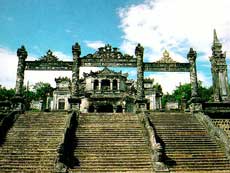
King Khai Dinh's tomb
|
The Nguyen Dynasty (1802-1945) was the last of the country’s royal families with 13 kings. However, for various reasons only seven complexes of tombs had been built for 9 Kings named as: Gia Long, Minh Mang, Thieu Tri, Tu Duc, Duc Duc, Thanh Thai, Duy Tan, Dong Khanh and Khai Dinh. Some of complexes are compounds of tombs of kings and queens.
Some famous royal complexes of tomb and temples of Kings Nguyen and pagoda outside Hue Citadel with different aspect are not only a wonderful arch but also combining beautiful, imposing nature and poetic of Hue which are must-see places when visiting Hue as follows:
King Minh Mang’s tomb
The height of the Nguyen Dynasty was reached during the reign of King Minh Mang (1820-1840) and his complex of tomb was built 12 kilometers from Hue between 1840 and 1843. It took ten thousand soldiers and artisans to complete the project. The complex of tomb consists of about 40 monuments of various sizes; all lie within an oval shaped wall with a circumference of 2000 meters.
|
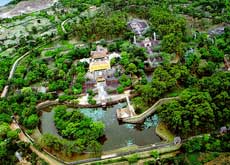
Overview of King Tu Duc's tomb
|
King Tu Duc’s tomb
Born in 1829, an expert in eastern philosophy, history and literature, King Tu Duc had the longest reign of all the kings of the Nguyen Dynasty. The King died in 1883 after 35 years on the throne. Built between 1864 and 1867, his complex of tomb includes 50 monuments and is surrounded by a 1,500 meter wall. |
Being a romantic, the king immersed himself in the world he created at the site of his complex of tomb which was designed as a fairyland with poetical features, making it a lifetime dream and a world for his eternal life after death.
King Khai Dinh’s tomb
It is the smallest but it took 11 years to complete, from 1920 to 1931, and has many elements of Western architecture. In fact, of all the tombs, Khai Dinh’s probably least resembles oriental architecture with its slate roof and wrought iron gate. Beyond modern building materials and designs, the tomb has elements of eastern art mixed with western designs. In the interior of the tomb, colored glass and ceramic chips were used to form mosaics of oriental design. The ceilings were hand painted much like the ceilings of western churches, but the designs are of dragons and clouds. That is why people consider King Khai Dinh’s complex of tomb an example of Vietnamese ‘neo-classicism’.
|
The complex of the Celestial Lady (Thien Mu) Pagoda has been adopted as the symbol of Hue City. The pagoda was built on the exact spot where, according to tradition, a "celestial lady" dressed in red appeared and asked the local lord to build a pagoda in order to control the subterranean forces and dominate the region. The first true pagoda was built between 1553 and 1613. |
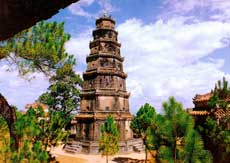
The seven-storey tower (Phuoc Duyen)
in Thien Mu Pagoda |
Between 1844 and 1846, the seven-storey tower (Phuoc Duyen), 21.24 metres high, was built on the orders of King Thieu Tri. Since then, right up to the present day, further construction and restoration work has followed. Behind the pagoda is a beautiful garden and a large glass encased smiling Buddha. To the left of the pagoda is a huge bell dating to the 18 century and is said to be audible 10 km away.
The road to Thien Mu Pagoda runs along the bank of the Perfume River and is great for a late afternoon ride as many boats are returning upriver.
Ancient Hue including Perfume River and Ngu Mountain, palaces and citadels, tombs, temples and pagoda with hundred of historic years are being embellished and recovered by material contribution of Vietnamese and International community in order to keep Hue City as World cultural heritage.
Phuong Anh (Collected)